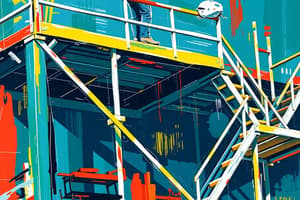Podcast
Questions and Answers
What does NFPA 10 stand for?
What does NFPA 10 stand for?
- National Fire Protection Association Safety Protocol
- National Fire Prevention Association Standard
- National Fire Protection Association Standard for portable fire extinguishers (correct)
- National Fire Program Assessment
What type of fire does a Class A fire involve?
What type of fire does a Class A fire involve?
Ordinary combustibles such as textiles, paper, plastics, rubber, and wood.
What is a Dry Chemical extinguishing system used for?
What is a Dry Chemical extinguishing system used for?
Protecting areas containing volatile flammable liquids.
What does Class B fire involve?
What does Class B fire involve?
What is the main characteristic of a Class C fire?
What is the main characteristic of a Class C fire?
What distinguishes Class D fire?
What distinguishes Class D fire?
What type of fire does a Class K fire involve?
What type of fire does a Class K fire involve?
What is Saponification?
What is Saponification?
Air-aspirating foam nozzles are designed for high-expansion foam.
Air-aspirating foam nozzles are designed for high-expansion foam.
What is deionized water?
What is deionized water?
What do clean agents replace?
What do clean agents replace?
How are Class K fire extinguishers tested?
How are Class K fire extinguishers tested?
Portable fires are identified using geometric shapes and ______.
Portable fires are identified using geometric shapes and ______.
How often should portable fire extinguishers be inspected according to NFPA 10?
How often should portable fire extinguishers be inspected according to NFPA 10?
What are the two designs for handheld dry chemical extinguishers?
What are the two designs for handheld dry chemical extinguishers?
What should be protected against freezing if exposed to temperatures below 40°F?
What should be protected against freezing if exposed to temperatures below 40°F?
Dry chemical agents are only for use on Class B fires.
Dry chemical agents are only for use on Class B fires.
Flashcards are hidden until you start studying
Study Notes
NFPA Standards
- NFPA 10 is the standard governing portable fire extinguishers.
Fire Classifications
- Class A fires: Involve ordinary combustibles (textiles, paper, wood); extinguished with water or water-based agents.
- Class B fires: Involve flammable liquids (gasoline, alcohol); extinguished with CO2, dry chemical, or Class B foam.
- Class C fires: Involve energized electrical equipment; water cannot be used until electrical energy is eliminated; requires non-conductive agents.
- Class D fires: Involve combustible metals (lithium, magnesium); require Class D dry powder extinguishers.
- Class K fires: Involve cooking oils; extinguished with wet chemical systems.
Extinguishing Agents
- Dry Chemical: Used for Class A, B, and C fires; protects areas with flammable liquids.
- Dry Powder: Specifically for Class D fires.
- Wet Chemical: Designed for Class K fires; uses a potassium-based agent for saponification.
- Clean Agents: Rapidly evaporating liquids, non-residue, effective on Class A, B, and non-conductive for C fires.
- Carbon Dioxide: Effective for Class B and C fires; displaces oxygen.
- Halogenated Agents: Chemical compounds containing halogens, primarily used for specialized fire suppression.
Extinguisher Designs
- Handheld Dry Chemical: Two types include cartridge-operated and stored-pressure, operating under about 200 psi.
- Wheeled Dry Chemical Units: Larger variant suitable for Class A, B, and C fires.
Extinguisher Ratings
- Class A rating: Ranges from 1-A to 40-A based on gallons of extinguishing agent.
- Class B rating: Ranges from 1-B to 640-B, based on square footage of a flammable liquid fire that can be extinguished.
- Class C rating: Focuses on electrical non-conductivity; no numerical rating.
- Class D rating: No numerical rating; includes application instructions.
- Class K rating: Tested to combat light cooking oil; must perform saponification.
Labeling
- Class A: Green triangle
- Class B: Red square
- Class C: Blue circle
- Class D: Yellow square
- Class K: Black hexagon
Inspection and Maintenance
- Portable extinguishers require inspection at least once a year.
- Key inspection factors: serviceability, accessibility, simplicity of operation.
- Every six years, dry chemical agents should be emptied and refilled.
- Water extinguishers should be protected against freezing below 40°F.
Studying That Suits You
Use AI to generate personalized quizzes and flashcards to suit your learning preferences.




